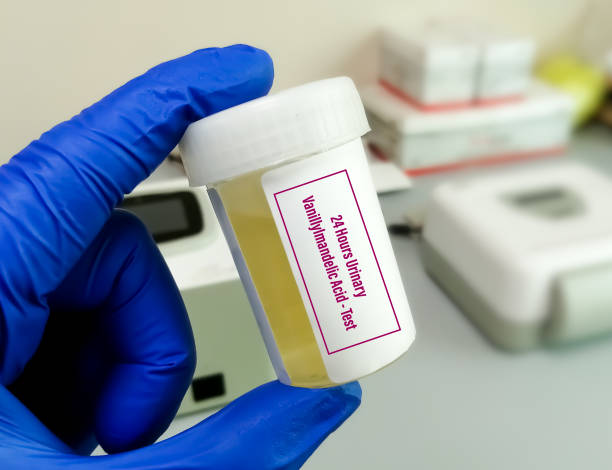
Urinary VMA (Vanillylmandelic Acid) and metanephrine tests are diagnostic tests used to evaluate certain types of tumors, particularly neuroendocrine tumors such as pheochromocytoma, neuroblastoma and carcinoid tumors.
Urinary VMA Test
Vanillylmandelic Acid (VMA) is a metabolite of the catecholamine neurotransmitters, such as epinephrine and norepinephrine. Increased levels of VMA in urine can indicate the presence of certain tumors, including pheochromocytoma and neuroblastoma. The test involves collecting a 24-hour urine sample, and the levels of VMA are measured in the laboratory.
Vanillylmandelic acid (VMA) is one of the breakdown products (metabolites) of epinephrine (adrenaline) and norepinephrine. Epinephrine and norepinephrine belong to a group of similar hormones called catecholamines. The VMA test measures the amount of Vanillylmandelic acid that is passed into the urine, typically over a 24-hour period, to detect excess epinephrine and norepinephrine and is used to detect tumors (neuroblastomas and other neuroendocrine tumors).
Who will need the test?
A VMA test may be ordered if the doctor sees the following symptoms of neuroblastoma in a child:
- Abnormal swelling or mass in the abdomen, neck or chest
- Bone pain
- Painless, bluish lumps under the skin
- Trouble breathing
- Bulging eyes
- Dark circles around the eyes
- Weakness of arms or legs
Other symptoms seen less commonly in neuroblastoma are:
- Fever
- High blood pressure
- Enlarged lymph nodes
- Easy bruising and bleeding
- Feeling tired
- Droopy eyelids
- Jerky muscle movements
- Uncontrolled eye movements
Urinary Metanephrine Test
This test measures the amount of metanephrines in the urine that our body makes over a 24-hour period.
Metanephrines are made when your body breaks down hormones called catecholamines. These hormones are made by the adrenal glands. Catecholamines help your body respond to stress. They are sometimes called "fight or flight" hormones. They also include epinephrine, norepinephrine, and dopamine.
This test measures the levels of metanephrines in urine and is used to diagnose and monitor the presence of tumors, particularly pheochromocytoma.
Who will need the test?
You may need this test if you have a condition called pheochromocytoma or paraganglioma. These are rare tumors that make extra amounts of catecholamines. Pheochromocytomas are found in the adrenal glands. Paragangliomas are found outside the adrenal glands.
Symptoms of pheochromocytoma or paraganglioma include:
- High blood pressure
- Paleness
- Headaches
- Sweating
- Heart palpitations
- Tremors
Carcinoid syndrome
This is a condition that occurs in patients with carcinoid tumors, which are slow-growing neuroendocrine tumors that can arise in various parts of the body. These tumors can produce and release hormones and other bioactive substances into the bloodstream, causing a range of symptoms. Some of the common symptoms of carcinoid syndrome include flushing of the skin, diarrhea, wheezing, and abdominal pain.
Bottom-line
It is important to consult with a healthcare professional for proper evaluation, diagnosis, and management of any medical condition, including neuroendocrine tumors and carcinoid syndrome.

